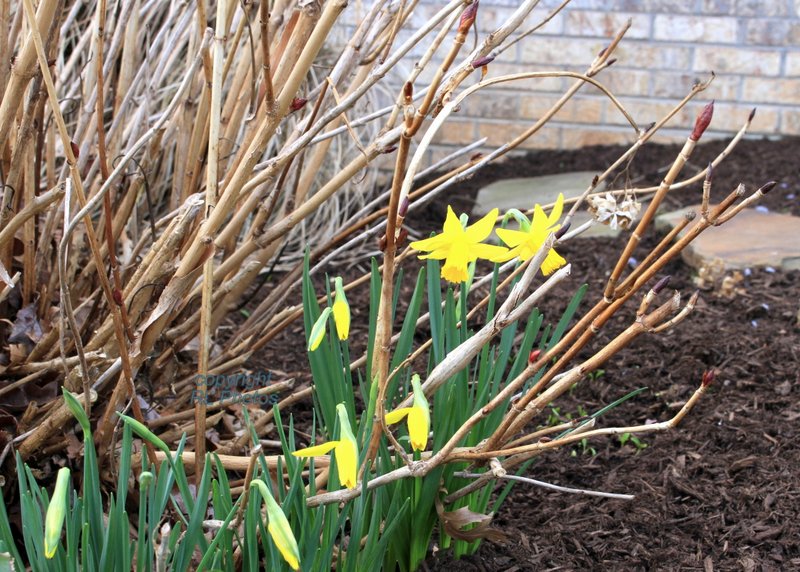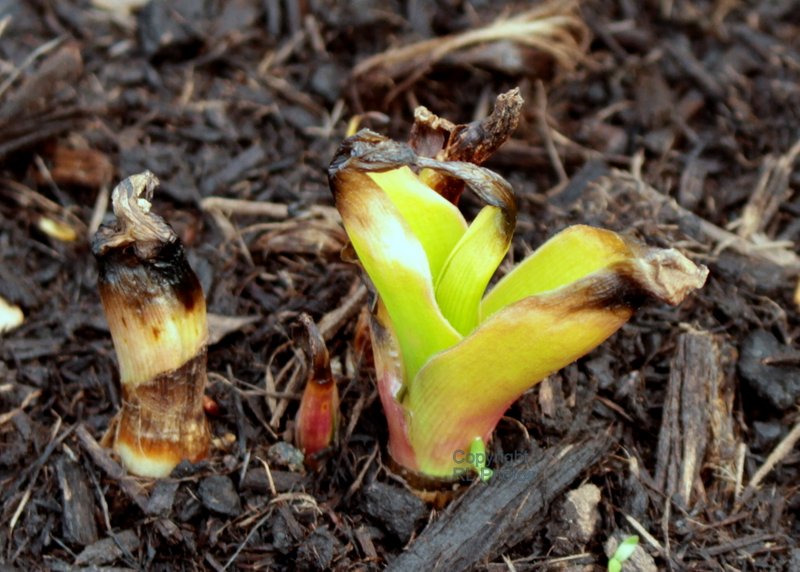Warm to Freezing and Back - What to Do?Really Warm to Cold and Back Again - A Tennessee Gardeners' Winter Nightmare - by R. Lieber This roller coaster winter (2016-2017) is following a wickedly hard summer of drought and heat. Many East Tennessee gardeners are reeling from the one-two punch. We were relieved to see lakes and livestock watering holes rising and our rivers looking close to capacity again. Then the weather turned, bringing us alternating days of springtime warmth with plenty of rain followed by bone chilling below freezing days. In mid January the first Carolina Yellow Jasmine began showing the pretty little yellow blooms that usually announce spring is coming. My cherry trees and daffodils were right behind!!
What to Do Right Now 1. Wait: Of course the one piece of sage advice we always hear from the experts has been to wait. It is good advice although we really all want to be able to DO something to save our green children. It is true, we do not know what the weather may bring, and there isn't much we can do to force all those buds to stop what they are doing. Many of our wayward plants are equipped to deal with a few brutally cold spells and will do fine. Of course when plants are on the edge of their zone for survival we may be out of luck no matter what we do. After two recent brutally cold winters, I waited for my Loropetalum to come back, and they did - in June! For those who feel they must do something, there are a few things you can do. 2. Mulch: One of the best tips year round has always been to mulch our flower beds, and this is true even now. Adding a layer of well composted material, shredded bark and other common mulches will help protect plants from any further swings in temperature in their root zones where the reserves for future growth and recovery reside. If you have Hellebore (Christmas Rose) be careful to not cover emerging leaves and buds since these plants thrive in cooler temperatures. Leave browned and damaged leaves from earlier in the year in place to help protect the new growth until at least early March. I asked Becky Heath from Brent and Becky's Bulbs to see what they recommend for bulbs right now, and she recommends temporary mulches and covers. "If you know a cold spell is going to hit your area, some light extra mulch like pine tags put over and around the emerging bulbs help protect the leaves from the drying winter wind and severe temperatures." 3. Cover every cold night: This has long been a way to keep plants blooming later in fall when the first frosts arrive and works just as well now for cold, but not subzero, temperatures. Plants, shrubs and short trees can be covered. Old sheets and light tarps are good covers to drape across planting beds. If you do cover your plants, do not leave covers on for the season because they will not help most plants and shrubs, and they can be detrimental. Wrapping plants up for winter protection all season has been a long held garden myth and won't do much good except for places that have drying winds all winter long.
1. Browned buds and leaves on bulb plants and most perennials that are already damage by cold snaps should be left in place until spring finally arrives. Becky Heath mentioned this when discussing how to deal with this winter's yo-yo weather and bulbs ” If the tips of the leaves get burned, the rest of the length of the leaves will come up green as it continues to mature throughout spring. The burned tips may not look as beautiful as you’d like, but normally has little effect on the flowers".
3. If only leaves grow and no blooms happen: It is not just bulbs that can end up being flowerless after severe freezing. Many early spring plants and shrubs, from Hydrangea to Witch Hazel and their cousin, the Loropetalum, and the earliest decorative cherries may all not bloom if their buds were opening when caught by a freeze. In most cases, the plant itself will survive and bloom next year. Becky Heath explains "If the flower is in bud and the temperatures change severely one way or the other, they could be ‘nipped in the bud’ and not open. This is very disappointing but again, normally has nothing to do with the life expectancy for the following year's blooms as long as they are in full sun and their leaves continue to photosynthesize, gathering energy for the following year’s bloom.
In future Hands in the Dirt articles, we'll be discussing other problems, like insects, that our much milder-than-normal winter will hand us. Keep an eye out for them!! |


 If you are among the many
gardeners worriedly inspecting their gardens, there is one clear
concern for many. What should we do to protect the many early
sprouting and blooming plants from the next arctic blast sure to hit
us in February or March, as has happened so often in previous years?
Bulbs are the most visible right now, but many other plants have also
been pushing up those tender buds and tentative green shoots, ready
for frost damage. Many garden plants are showing some of the
stresses; roses are showing buds as are the early maples and willow
trees. It is the first week of February and my beloved hydrangea
has swelling buds and a handful of leaves showing. It doesn't seem
to be looking good for flowers this spring and summer!
If you are among the many
gardeners worriedly inspecting their gardens, there is one clear
concern for many. What should we do to protect the many early
sprouting and blooming plants from the next arctic blast sure to hit
us in February or March, as has happened so often in previous years?
Bulbs are the most visible right now, but many other plants have also
been pushing up those tender buds and tentative green shoots, ready
for frost damage. Many garden plants are showing some of the
stresses; roses are showing buds as are the early maples and willow
trees. It is the first week of February and my beloved hydrangea
has swelling buds and a handful of leaves showing. It doesn't seem
to be looking good for flowers this spring and summer! What to Do After - following ruined
buds, browned leaf tips, and after flowers die off
What to Do After - following ruined
buds, browned leaf tips, and after flowers die off 2. Leaf tips that have stopped growing are not dead, so leave your tulips, bulb iris, and alliums be. They
should be fine and begin growing again closer to their normal time
and bloom right on schedule. Old House gardens founder Scott Kunst
also shared some information with me. His blog post on
the subject, that may make it easier to understand just how resilient
many of our bulbs are with this information: "Most
fall-planted bulbs, for example, require a certain number of hours
below 40 degrees or so in order to produce enough gibberellic acid to
allow the leaves and flower stems to lengthen normally — which
means most foliage won’t emerge very far above ground this early.
And most bulb foliage and even flowers can take freezing in stride.
When temperatures drop below 15 degrees or so, any foliage that’s
above ground may be killed, but whatever is still underground will be
unharmed and continue growing normally in the spring."
2. Leaf tips that have stopped growing are not dead, so leave your tulips, bulb iris, and alliums be. They
should be fine and begin growing again closer to their normal time
and bloom right on schedule. Old House gardens founder Scott Kunst
also shared some information with me. His blog post on
the subject, that may make it easier to understand just how resilient
many of our bulbs are with this information: "Most
fall-planted bulbs, for example, require a certain number of hours
below 40 degrees or so in order to produce enough gibberellic acid to
allow the leaves and flower stems to lengthen normally — which
means most foliage won’t emerge very far above ground this early.
And most bulb foliage and even flowers can take freezing in stride.
When temperatures drop below 15 degrees or so, any foliage that’s
above ground may be killed, but whatever is still underground will be
unharmed and continue growing normally in the spring." 4. It looks dead - I had better pull it out: One
word: DON'T!!! Sometimes more than just the flower buds are damaged
and it is the buds for leaves and stems that have become browned and
dried out husks. The advice from the experts goes back to the first
thing we discussed: WAIT! Even a plant that has broken dormancy
still has most of its vital energy below ground in the roots. It may
take some time before it is able to push up additional growth to take
advantage of true spring, and is nature's way of dealing with highly
variable weather and saving a little of itself just in case. With
Hydrangeas, you risk cutting off parts of stems that will grow leaves
and later flowers by trimming what appears to be brown buds and
stems. On trees and shrubs that appear to have been damaged, wait
until at least the end of March or early April to test the
bend-ability of the twigs and stems that appear dead. If they snap
easily, you have a dead twig that needs pruning; but if it still is
pliable, wait a while longer and you will be rewarded with new growth
gradually making its appearance.
4. It looks dead - I had better pull it out: One
word: DON'T!!! Sometimes more than just the flower buds are damaged
and it is the buds for leaves and stems that have become browned and
dried out husks. The advice from the experts goes back to the first
thing we discussed: WAIT! Even a plant that has broken dormancy
still has most of its vital energy below ground in the roots. It may
take some time before it is able to push up additional growth to take
advantage of true spring, and is nature's way of dealing with highly
variable weather and saving a little of itself just in case. With
Hydrangeas, you risk cutting off parts of stems that will grow leaves
and later flowers by trimming what appears to be brown buds and
stems. On trees and shrubs that appear to have been damaged, wait
until at least the end of March or early April to test the
bend-ability of the twigs and stems that appear dead. If they snap
easily, you have a dead twig that needs pruning; but if it still is
pliable, wait a while longer and you will be rewarded with new growth
gradually making its appearance.